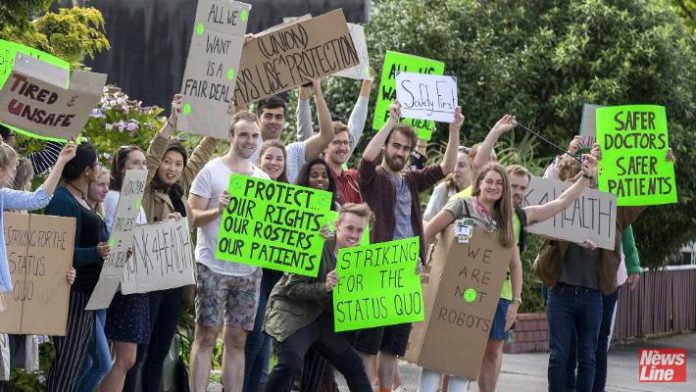Thousands of New Zealand junior doctors walked off the job for a record five days from Monday in the fifth and longest strike for the workforce so far this year.
New Zealand Resident Doctors’ Association (NZRDA) members have previously gone on four 48-hour strikes after more than a year’s worth of negotiations with District Health Boards (DHB) about their contract.
The strike is having ‘major impacts’ on hospitals and patients, the doctors’ union says.
Junior doctors aren’t striking for the money, the union insists. They simply want to retain a number of key conditions in their contracts.
Junior doctors – resident medical officers or RMOs – are registered medical practitioners ranging from graduates fresh out of medical school to those with 12 years’ experience.
They include members of the Resident Doctors Association, members of Speciality Trainees of New Zealand (SToNZ), and doctors who are not part of either union.
There are about 3,300 RDA members, with the majority striking from 8am on Monday, 29th April until 8am on Saturday, 4th May.
The strike covers all DHBs except Canterbury, where the hospital remains under pressure following the 15th March mosque shootings.
The strike is the fifth and longest strike by the junior doctor workforce, fed up of failed negotiations with the DHBs.
‘This isn’t about the money,’ NZRDA senior official David Munro said.
‘The dispute is mostly about who should have the final say over changes to junior doctors’ working arrangements – the union or the DHBs.
‘Essentially, junior doctors are striking to protect existing conditions and provisions in their contracts which the DHBs are trying to undermine,’ Munro said.
‘The key issues include where junior doctors can be moved to work (rotation), education and training, and rosters and hours of work.
‘RMOs are a training apprenticeship workforce, frequently moving between DHBs as part of their training.
‘Under the current contract – which expired in February 2018 – DHBs can’t cut training courses and roster working hours in their place without the agreement of the union, and the NZRDA wanted to protect that,’ Munro said.
NZRDA also wants to retain the safer staffing rosters it fought for in 2016.
The MECA (Multi-Employee Collective Agreement) states they can’t work more than ten days in a row or four nights in a row, and can’t be on an on-call roster after a 16-hour shift.
DHB employers want to change the MECA so any changes to rosters or working arrangements can be approved at individual hospitals, which NZRDA says will take the ability off them to veto rosters and agreed-on training arrangements.
The Employment Relations Authority has granted NZRDA facilitation, set down for 9th, 10th, 13th and 14th May.
Facilitation allows parties to have a third-party make a decision on a bargaining outcome.
The determination is not binding however, and the parties may or may not accept it.
Munro said if the recommendation went completely against what the DHBs want and they refuse to accept it, further strike action could be imminent.
About 30 striking junior doctors and supporters protested outside Health Minister David Clark’s office at midday on Monday.
Junior doctor Courtney Brown said: ‘The point of this fifth strike is to ensure we get a settlement at the end of that process.’
The doctors cancelled a strike planned for 15-18 April over technical problems, before voting on an unpredecented five-day strike starting 29 April.
They have held four two-day strikes since mid January.
Munro said: ‘The clawbacks that the DHBs have put on the table they are showing no sign at this stage of removing.
‘And that is a simple impact that could see a much swifter move to settlement of this long-running dispute.’
Doctor Ivan Popovich said: ‘We know we are going to work long hours but all we want in return is to maintain what we’ve fought to achieve for the last long while in our contract and not have that eroded or taken away.’
At Auckland, emergency department doctor Christina Vanderboor warned that the proposed changes would be dangerous: ‘You’re trying to make decisions and you’re trying to focus on reading an ECG or reading lab results and you really have to focus your brain.’
Nurses are on the doctors’ side, with the Nurses Union’s industrial advisor, Lesley Harry, urging DHBs to settle the row.
‘We don’t support unsafe rostering practices. We’re aware that junior doctors have, over a long, very long period of time, worked excessive hours,’ she said.
There is a broadening demographic entering the profession, from diverse backgrounds, and although pay can be good at consultant and GP level, at the resident doctor stage many owe hundreds of thousands of dollars in student loans, after attending university study lasting between six and ten years.
Many have families, partners who have their own careers and school age (and sometimes university age) children. Frequently moving around the country to meet training requirements, their lives can be peripatetic and disrupted.
Study for specialty exams can pose major challenges to individual wellbeing, and family life, and is associated with high levels of psychological distress.
Doctors have a very high rate of suicide compared to the general population.
Shift work is well recognised to be detrimental to health, with night shift workers at higher risk of depression, high blood pressure, obesity and cancer.
Long hours and sleep deprivation places both doctors, and the patients they care for, at risk.
With a readiness to strike that is unusual among doctors’ unions worldwide, and other health unions locally, the RDA has been extremely successful in improving working conditions for junior doctors.
Junior doctors have won reduced overall working hours, limits on the number of consecutive day and night shifts that can be worked, protections around rest time, reimbursement of the substantial costs of post-graduate training, and security of employment, as well as consultation on safer staffing and roster design.
